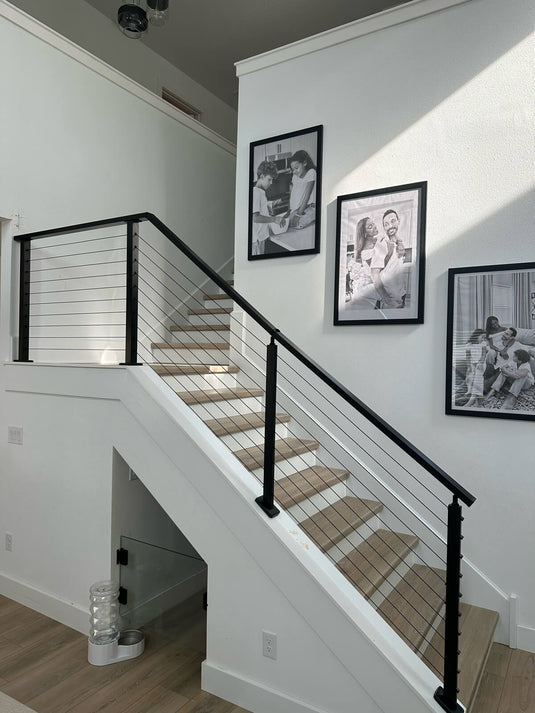TABLE OF CONTENTS
What are Floating Stair Treads?
A floating stair tread is the individual, flat surface that forms each step of a floating staircase. These treads are the defining feature that gives the staircase its signature look, as they appear to be suspended without visible support. Each tread is carefully designed and installed to create the illusion of floating while providing a safe, stable surface for walking.
Key characteristics of floating stair treads include:
● Minimalist Structure: Treads are typically installed without risers, contributing to the open, airy aesthetic of the staircase.
● Cantilevered Support: Treads are anchored to a load-bearing wall or a concealed steel frame, often using steel brackets or plates embedded within the tread for strength.
● Material Variety: Treads can be crafted from materials like hardwood, tempered glass, polished concrete, or metal, offering endless design possibilities.
● Visual Impact: The lack of visible supports makes each tread appear to float independently, creating a striking visual effect.

Common Shapes of Floating Stair Treads
1. Square or Rectangular Treads
This is the most commonly used tread shape in floating stairs. With clean edges and balanced proportions, they complement modern, minimalist interiors and work well in straight stair designs.
2. L-Shaped
TreadsL-shaped treads are typically used in zigzag or folded plate staircases. The angular shape mirrors the support structure underneath and creates a continuous visual rhythm along the stair's incline.
3. Box Treads
Box treads are thicker and appear as solid blocks, often hollow inside for weight reduction. Fully enclosed on all sides, they enhance the floating effect and bring a strong architectural character to the stairs.

Best Materials for Floating Stair Treads
Choosing the right material for your floating stair treads is essential for both aesthetics and functionality. The material you select not only affects the appearance of your staircase but also its durability, maintenance, and cost.
Hardwood treads like oak, walnut, or maple are a classic choice for floating stairs. They bring warmth and texture, making them perfect for residential interiors. Wood is also relatively easy to customize and refinish.
Watch out for: Scratches, moisture sensitivity, and regular maintenance


Tempered glass treads create a stunning, ultra-modern effect by allowing light to pass through. They’re often paired with minimalist steel brackets or LED lighting for extra flair.
Watch out for: Smudges, fingerprints, and the need for frequent cleaning
Steel or aluminum treads are extremely durable and bring an industrial or contemporary edge. They’re often used in lofts, offices, or minimalist homes.
Watch out for: Noise underfoot


Polished concrete or natural stone treads are long-lasting and create a bold architectural statement.
Watch out for: Heavy weight and costlier structural support
How to Install Stair Treads?
The installation of floating stair treads involves sophisticated engineering to achieve both the aesthetic and functional requirements. Here’s a simplified overview:
1. Support System: Treads are anchored to a load-bearing wall or a hidden stringer. The support must be robust enough to handle the weight of users and dynamic loads.
2. Cantilever Mechanism: Each tread is bolted or welded into the support structure, with reinforcements like steel plates or brackets embedded to ensure stability.
3. Material Finishing: The visible surface of the tread is finished with the chosen material, such as polished wood, glass, or stone, to achieve the desired look.
Proper installation is essential to meet building codes, ensuring the treads can support weight safely and that handrails or other safety features are included as needed.
Floating Stair Treads vs Traditional Stair Treads
When comparing floating stair treads to traditional stair treads, the differences go far beyond aesthetics. Here's a breakdown of how these two designs stack up:
Aesthetics
● Floating stair treads offer a sleek, minimalist, and airy feel, ideal for modern interiors.
● Traditional stair treads are more enclosed and solid, often suited to classic or rustic designs.
Structure and Installation
● Floating treads require advanced engineering and precise installation using hidden supports.
● Traditional treads are supported by visible stringers on either side, making them easier and more affordable to build.
Cost
● Floating stairs are typically more expensive due to custom fabrication, higher-end materials, and complex installation.
● Traditional stairs are cost-effective and easier to maintain.
Light and Space
● Floating treads allow light to flow through and preserve openness in smaller or darker spaces.
● Traditional stairs can block light and make spaces feel more compartmentalized.
● Traditional stairs often feel safer for children and the elderly because of their closed risers.
● Floating treads must be carefully designed to meet code and may not suit all users.
Ultimately, the decision comes down to your budget, design vision, and practical needs. Floating stair treads are perfect for those seeking innovation and elegance, while traditional treads offer familiarity and simplicity.

Building Codes & Safety Standards(IRC 2024 & IBC 2024)
When designing or installing a staircase—especially a floating staircase—compliance with the building code for stairs is crucial to ensure both safety and functionality. The 2024 editions of the International Residential Code (IRC) and International Building Code (IBC) provide clear guidelines on tread depth, riser height, load capacity, slip resistance, and more.
📚 Residential floating staircase: IRC 2024
📚 Commercial floating staircase: IBC 2024
1. Tread Depth
● IRC 2024 [R311.7.5.2]:
Minimum tread depth is 10 inches (254mm) with nosing, or 11 inches (279mm) without nosing.
● IBC 2024 [1011.5.2]:
Tread depth must be 11 inches (279mm) minimum for commercial applications.
2. Riser Height
● IRC 2024 [R311.7.5.1]:
Maximum riser height is 7¾ inches (196mm), minimum 4 inches (102mm).
● IBC 2024 [1011.5.2]:
Maximum riser height is 7 inches (178mm), minimum 4 inches (102mm).
3. Uniformity (Tread and Riser Variation)
● IRC 2024 [R311.7.5.2.1]:
The greatest tread depth or riser height within any flight must not vary by more than 3/8 inch (9.5mm).
● IBC 2024 [1011.5.4]:
Same: maximum variation allowed is 3/8 inch.
4. Open Risers
● IRC 2024 [R311.7.5.1]:
Open risers are permitted if the opening between treads does not allow passage of a 4-inch (102mm) sphere.
● IBC 2024 [1011.5.5.3]:
Same for commercial stairs.
5. Tread Thickness
● General Recommendation (not explicitly specified in IRC/IBC):
For open-riser stairs, a minimum tread thickness of 1.5 inches (38.1mm) is strongly recommended to ensure load support and structural strength.
(Industry best practices, rather than code mandate.)
6. Load Capacity
● IBC 2024 [1607.1 / Table 1607.1]:
Each tread must support:
A minimum concentrated load of 300 pounds (136kg) applied over a 4-inch x 4-inch area.
A live load of 100 pounds per square foot (psf) (4.8 kPa) for stairways.
7. Materials and Slip Resistance
● IRC 2024 [R311.7.1] and IBC 2024 [1011.7.1]:
Stair surfaces must be slip-resistant.Especially for exterior stairs, materials like treated wood, composites, metal, or textured finishes must be used to prevent slipping.
8. Drainage for Exterior Treads
● IBC 2024 [1011.7.2]:
Outdoor stair treads must be designed to prevent water accumulation, using sloped surfaces (up to 2%) or drainage openings.
9. Side Gaps
● Based on general code interpretations:
Gaps between the stair tread and adjacent walls should ideally not exceed ½ inch (12.7mm).
However, if treated like open risers, a maximum of 4 inches (102mm) may be acceptable under certain conditions.
10. Headroom
● IRC 2024 [R311.7.2] and IBC 2024 [1011.3]:
Minimum headroom clearance of 80 inches (2032mm) measured vertically from a tread nosing.




